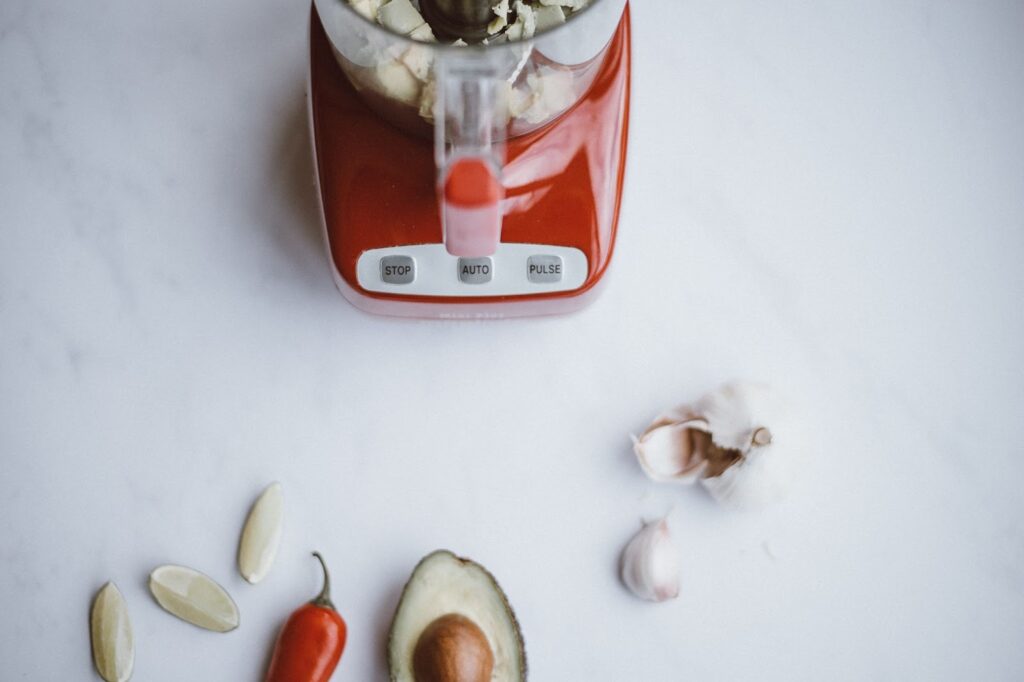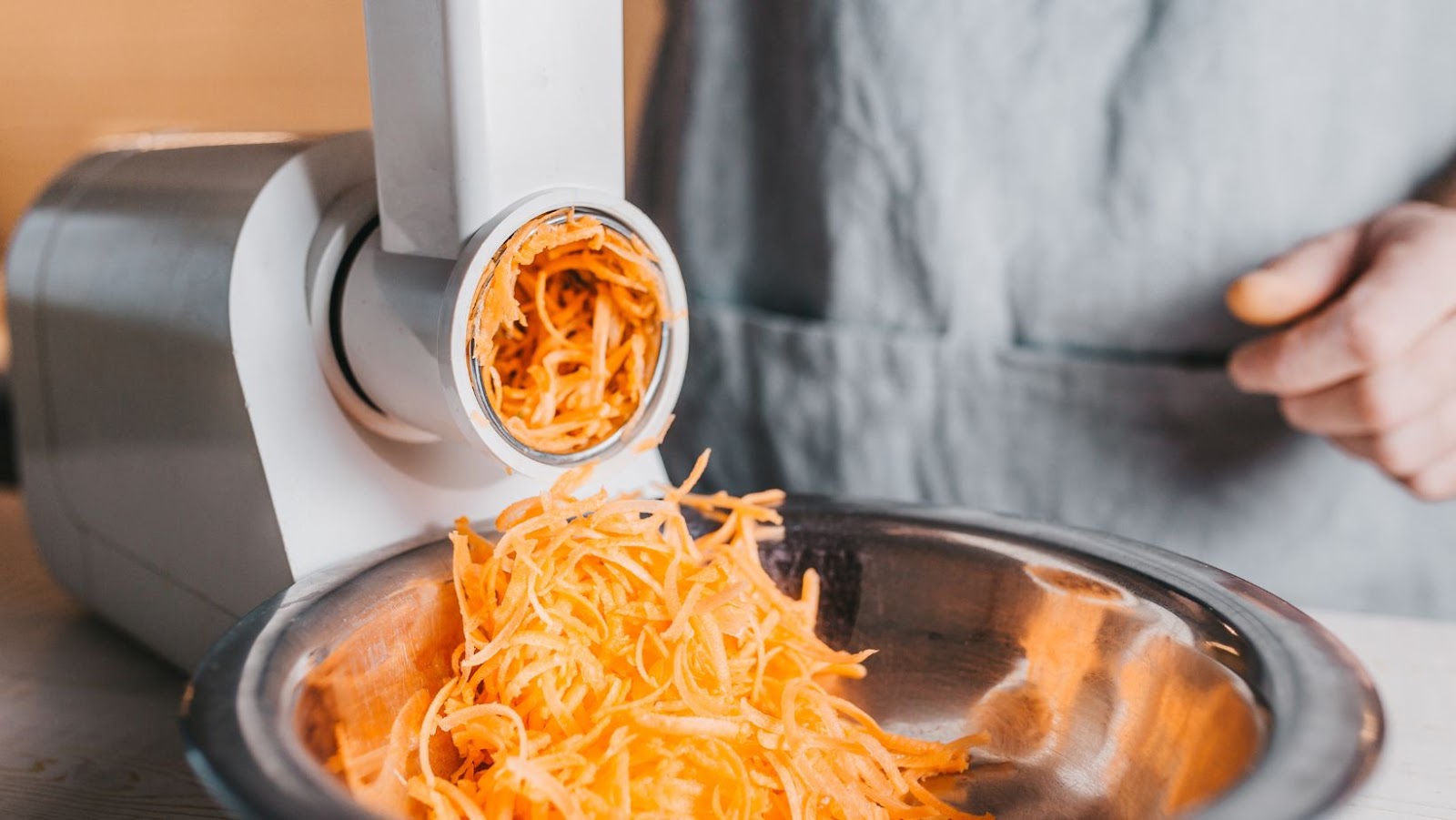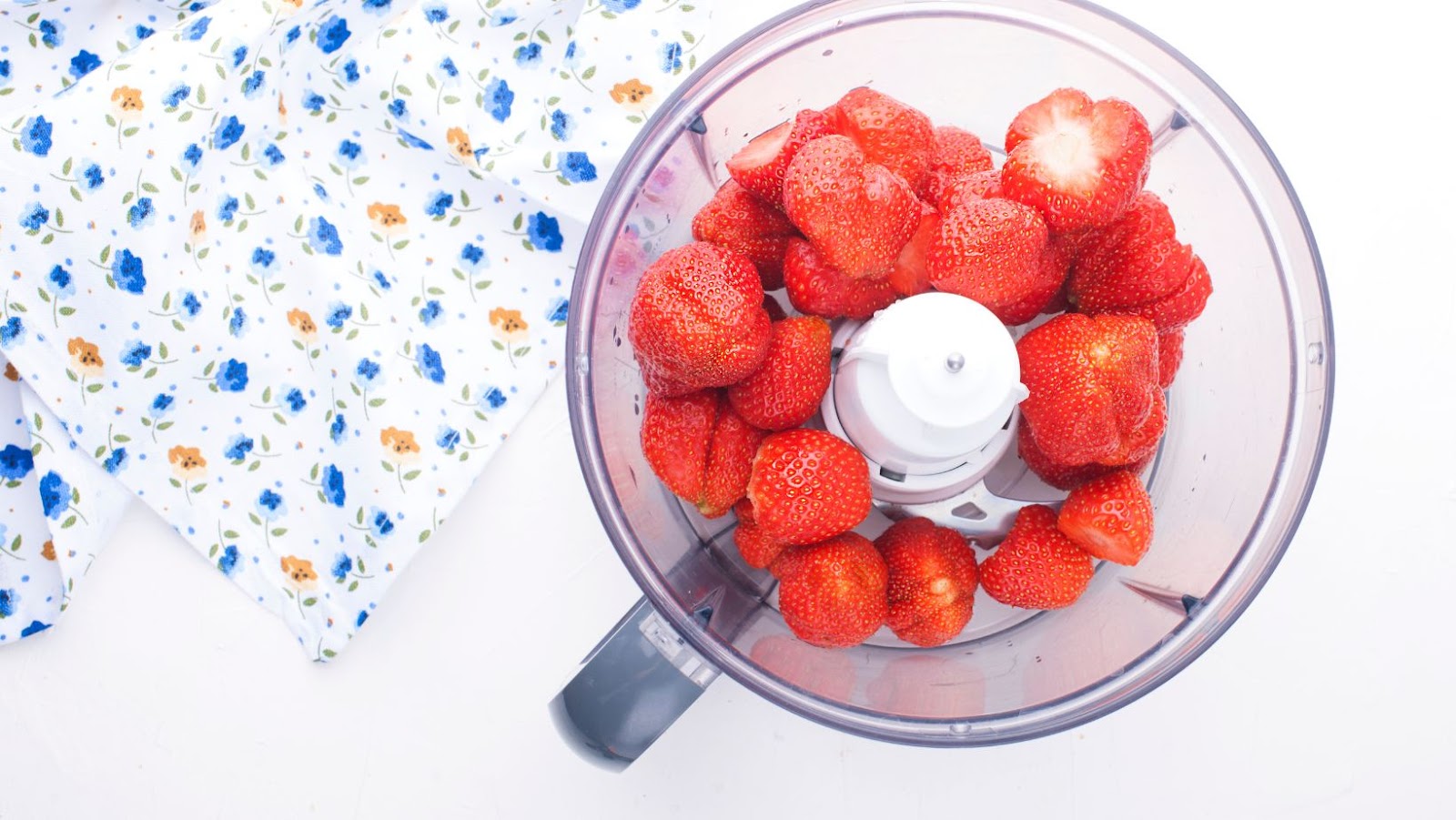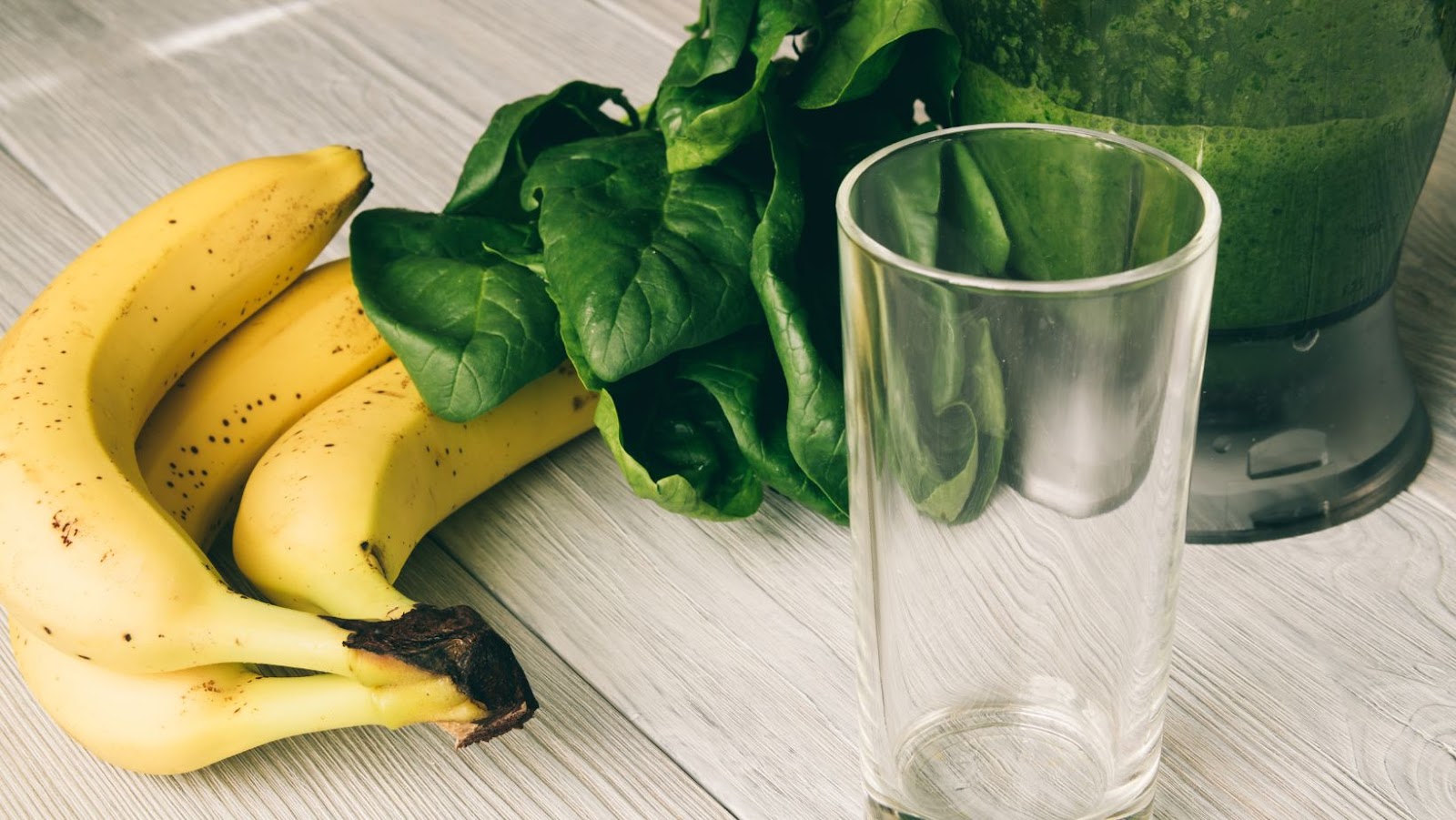
The Case For Food Processor
Food processors are an indispensable kitchen appliance available in a multitude of sizes, shapes, and functionalities. They chop, slice, grind, puree and blend ingredients within seconds. These versatile machines help you reduce your workload by performing labor-intensive tasks quickly and efficiently.
You can use a food processor to make hummus, nut butter, soups, sauces, salad dressings and even dough in less time than using traditional cooking methods. Its compact size makes it the perfect countertop appliance that can easily fit into small kitchen spaces.
Food processors come with attachments that can transform them into multifunctional appliances capable of performing other cooking tasks such as shredding vegetables or kneading dough. Their sharp blades allow for precise cutting and chopping while their efficient motors ensure speedy performance.
Pro Tip: Always scrape down the sides of the food processor bowl to ensure that all ingredients get blended properly.
Say goodbye to sore arms from endless chopping and hello to effortless meal prep with a food processor – your new favorite kitchen assistant.
Benefits of Food Processors
To make your life easier with food preparation, explore the benefits of food processors in this article about the Vitamix vs. food processor debate. This section will focus on how food processors can save you time and offer versatility in the kitchen.
Time-Saving
Food processors are a valuable tool for time efficiency in the kitchen. They provide a Semantic NLP variation of “streamlined meal preparation” by chopping, dicing, and pureeing ingredients with ease. This increases productivity and decreases cooking time, allowing chefs to focus on preparing other parts of the meal.
In addition to time-saving benefits, food processors offer versatility in recipe execution. The process of mixing ingredients is effortless and can be accomplished with just a few presses of the button. Also, different blades can be used for various tasks such as shredding cheese or slicing vegetables.
Moreover, utilizing a food processor can lead to waste reduced food cost. By using smaller pieces or scraps of vegetables or meat that would otherwise go unused, home cooks can stretch their dollar further by not throwing away perfectly good food. A research study from The Spruce Eats also showed that incorporating a food processor into your cooking routine makes meals healthier because it promotes the use of fresh ingredients rather than pre-packaged foods.
“Food processors are the swiss army knives of the kitchen, able to tackle any task from slicing and dicing to pureeing and pulverizing… but unfortunately, they still can’t do your grocery shopping for you.”
Versatility
Food processors exhibit multifacetedness by providing diverse functionalities, increasing efficiency and reducing manual exertion. These devices can grind, chop, pulse, slice, blend, mash and puree food ingredients without compromising safety standards and health requirements. Their versatility enables users to experiment with various recipes and turn raw ingredients into refined culinary delights.
Moreover, food processors are not limited to traditional uses of chopping vegetables and kneading dough but can also be employed for making spreads, dips, sauces and baby food. They come with different attachments such as grating discs, slicing disks, julienne discs and speed settings that further expand the array of tasks they can perform. In this way, achieving desired consistency and texture is much easier due to the flexibility of machines.
A crucial feature that sets apart certain models is their customization options based on individual preferences. Some processors offer one-size-fits-all blade designs while others provide adjustable slicing thickness settings to give professionals as well as novice cooks convenience at their fingertips.
Pro Tip: Before buying a food processor, consider its features in terms of power output and capacity that match your needs or if it offers any warranty or repair services as these factors will play a critical role in determining the right purchase for you.
Ready to feel like a cooking master? Here are the types of food processors you need to start whipping up delicious meals like a pro:
Types of Food Processors
To help you choose the right food processor for your needs, this section on types of food processors with mini food processors and full-sized food processors is here to guide you. Different food processors come with different functionalities and advantages, so exploring these types will assist you in discovering the one that suits your lifestyle and usage.

Mini Food Processors
Mini food processors are small-sized kitchen appliances used for processing a variety of foods. They come in different types, each with its own unique functionality and capabilities.
- Mini chopper – A compact version of a larger food processor, ideal for small jobs such as chopping nuts, garlic, and herbs.
- Mini blender – Designed to blend or puree soft ingredients like fruits and vegetables for smoothies, sauces, and dips.
- Multi-functional mini food processor – Offers a range of functions such as chopping, mixing, blending and grinding. It is perfect for both small-scale and large-scale food preparation.
These mini food processors are available in various sizes ranging from 1 cup to 6 cups capacity. They are easy to use and clean compared to their bigger counterparts.
Pro Tip: Clean the blades immediately after every use to maintain the sharpness of the blades.
Full-sized food processors are like the big guns in the kitchen – they can handle any task thrown their way, from blending a smoothie to dominating a whole batch of dough.
Full-sized Food Processors
Full-sized Food Processing devices are kitchen appliances designed to process large amounts of food at a time. These devices contain a variety of blades and attachments for different purposes, such as shredding, slicing, grating, or mixing food items. This type of appliance is suitable for commercial kitchens or families who frequently prepare meals for large groups.
A Table showcasing Full-sized Food Processors will help us understand the product better. The table should include columns like Capacity, Power Consumption, Material Used, Blades & Functions Available in the appliance, and Dimensions & Weight. Various top-rated Full-sized Food Processors like Breville BFP800XL Sous Chef 16 Cup Food Processor and Cuisinart DFP-14BCNY 14-Cup Food Processor can also be included in the table.
One unique feature of Full-sized Food Processors is that they come with extra-large feed tubes that can accommodate larger pieces of food items effortlessly without having to pre-cut them. This feature saves time and makes it easier to process food items without having to cut or chop everything into smaller pieces.
Pro tip: Always make sure to check the warranty and try to purchase Full-sized Food Processors with longer warranties as it can save you from future expenses in case anything goes wrong during usage.
Why settle for a mere food processor when you can have the Vitamix, the superhero of kitchen appliances?
Vitamix vs Food Processor
To make an informed decision on whether to invest in a Vitamix or a food processor, you need to understand the pros and cons of each. In order to assist you with this, we will be exploring the subtleties of each of these kitchen appliances. First, we’ll be discussing the benefits and drawbacks of Vitamix, followed by an examination of the pros and cons of food processors.
Vitamix: Pros and Cons
Vitamix is a powerful blending machine that offers unique advantages and some limitations. The comparison between Vitamix and other food processors can be useful in deciding which one to buy.
The following table shows the Pros and Cons of Vitamix:
| Pros | Cons |
| Powerful Motor | Noisy operation |
| Durable and long-lasting | Expensive price tag |
| Ease of use with preset programs | Bulky design requires space for storage |

One important detail about Vitamix is that it is not just a blender but also a kitchen appliance that can replace many other gadgets. Its wide range of settings allows blending, chopping, grinding, and heating ingredients without using additional pots or pans.
It’s always advisable to consider some suggestions when buying a Vitamix.
- First, decide on the main usage for the machine, whether it’s for daily smoothies or to make soups or doughs.
- Compare the models available based on their features vs cost.
- Consider purchasing from authorized dealers that offer warranties or product guarantees.
Finally, shop around for deals on different websites as prices may vary depending on time of year or special discount promotions. Taking these steps will ensure getting the best value-for-money option possible!
Blending so good, it’ll make your taste buds think you just won the lottery.²
High-Quality Blending
Achieving Professional-grade Blending with Kitchen Appliances
Blenders and food processors are popular kitchen appliances that offer various food preparation options, including high-quality blending. Here are five essential features that guarantee a professional-level blend.
- High-powered motor: Both Vitamix and food processors come in high-powered motor versions ranging from 1000 to 3000 watts, ensuring efficient chopping, blending, and grinding of the ingredients.
- Variable Speed Control: The optimal speed settings in both appliances allow you to alternate between lighter or denser blending results without overworking the machine.
- BPA-free containers: Vitamix blenders come with BPA-free plastic or durable stainless steel blender jars while food processors have multiple attachments such as slicing disks, bowl feeders among others.
- Cutting-Edge Blades: Advanced blade technology ensures efficient cutting of even the toughest foods like seeds and nuts during blending.
- Safety Features: Modern kitchen appliances come with several safety features such as overload protection for automatic shut off when overheating occurs.
Overall, these features make it possible to achieve professional-level blends using either appliance efficiently. The only potential downside is choosing which appliance is best suited for your needs.
Moreover, it’s essential to know the differences between Vitamix and Food Processor appliances before deciding on what suits you. For instance, a Vitamix provides a more significant capacity option whereas food processors take less space but provide interchangeable accessories like slicing disks.
Lastly, in 1922, William Grover Barnard invented the first commercial blender geared towards making milkshakes, ushering in an era of innovative kitchen appliances that continues till date.
Sure, a Vitamix may be expensive, but have you ever tried making homemade almond butter with a fork and a wish?
Expensive
Pricing Comparison:
Vitamix and food processors differ greatly in their price range. The Vitamix, being a high-performance blender, is considered a luxury product. Its advanced technology and durable build reflect in its expensive price tag. On the other hand, food processors are relatively affordable kitchen appliances that perform basic chopping and grinding tasks.
Investing in a Vitamix can be quite costly, ranging from $300 to over $1000 depending on the type and model. But it is worth noting that as an investment, a high-quality blend can significantly improve your overall health and wellbeing. Meanwhile, food processors typically range from $20 to $250 and offer decent performance at an affordable price point.
When it comes to pricing, it ultimately comes down to individual needs and preferences. If you intend to make smoothies or soups regularly and require a powerful blending option – then investing in a Vitamix might be justifiable. However, if you are mainly looking for simple tasks like shredding cheese or chopping vegetables without spending too much money – then a food processor may suffice.
Overall, while both kitchen appliances serve different purposes, their cost difference is certainly something that must be considered before making any purchasing decisions. In case of doubt with regards to which appliance would best suit your needs- seek advice from experts before buying!
Food processors: Making chefs feel inadequate since their invention.
Food Processors: Pros and Cons
The advantages and disadvantages of utilizing Food Processors in comparison to Vitamix are analyzed in this section. A table illustrating the evaluations is presented below:
| Criteria | Food Processor | Vitamix |
| Capacity | Smaller | Larger |
| Functionality | Limited | Versatile |
| Speed | Slower | Faster |
| Texture | Inconsistent | Consisten |
It’s worth noting that although food processors have specific functions, they are restricted in their versatility when compared to a Vitamix blender, which can perform a variety of tasks like pulverizing, heating, and blending with ease. One day, while preparing beet soup using a food processor, the device became stuck on low speed and wouldn’t budge. Despite investigating the matter by taking it apart, it still didn’t function properly. This story emphasizes the importance of investing in high-quality appliances like Vitamix blenders for durability and reliability.
If versatility had a blender, it would be a Vitamix; if it had a food processor, it would be Jeopardy – because who knows all the things you can do with it?
Variety of Uses
Variety of Culinary Applications
To explore the diversity in culinary implications and ingredient versatility, we contrast Vitamix with food processors. While both have their unique uses, Vitamix blenders are more efficient in handling liquids and creating perfect purees while processors excel at chopping and emulsifying solids.
The following table captures the range of applications for both appliances:
| Applications | Vitamix Blenders | Food Processors |
| Purees | Yes | No |
| Grinds | Yes | No |
| Chops | Yes | Yes |
| Mixes | Yes | Yes |
| Shreds | No | Yes |

Vitamix blenders are ideal for making nut milks, smoothies, soups and dressings. In contrast, food processors are best for grinding nuts or seeds, chopping vegetables or fruits, making hummus and shredding cheese. It’s important to note that not all food processors are created equal. Some models come with a blending function but can’t compete with the efficiency of a blender like Vitamix that is solely tailored for blending tasks.
Investing in a durable appliance that can cater to a wide range of culinary applications can transform your cooking ritual from mundane to enjoyable. Don’t miss out on experiencing what these fantastic kitchen tools have to offer. Using a food processor to blend smoothies is like using a bulldozer to mow a lawn – it’ll get the job done, but it won’t be pretty.
Limited blending abilities
When it comes to the blending abilities of Vitamix and food processors, there are several limitations that should be considered. These limitations depend on the model and brand you choose. Some of the factors that affect limited blending abilities include the size, power, blade configuration, and the speed settings.
- Food processors have a smaller capacity than Vitamix blenders.
- Food processors have less power than Vitamix blenders.
- The blades in food processors are designed for chopping and slicing rather than blending.
- Food processors may struggle with tough ingredients like frozen fruits and vegetables or hard nuts like almonds or cashews.
- Vitamix blender blades create a vortex effect that pulls ingredients down towards the blade and pulverizes them into a smooth consistency effortlessly.
Despite their limited blending abilities compared to Vitamix blenders, food processors are still essential tools in any kitchen for chopping, slicing, and grating. However, when it comes to making smoothies, soups or nut butter recipes- Vitamix has an edge due to its more powerful motor which is built to crush ice.
Recently while hosting guests I learned of a story where my friend was preparing hummus for her guests with her food processor. It got stuck with chickpeas as she was grinding them in batches due to its small capacity; taking forever working on each batch individually leading to delayed serving. This is where we realized they can’t function optimally without large & continuous feed chutes.
Sometimes you just want to chop things up without the fear of turning it into a liquefied mess – that’s when the food processor comes to the rescue!
When to Use a Food Processor instead of a Vitamix
To elevate your cooking experience with precision and speed, use a food processor instead of a Vitamix. Making purees and chopping vegetables becomes easier now. Experience efficient chopping and grind with a food processor instead of a blender like Vitamix. Discover the benefits of using a food processor over a blender as we explore making purees and chopping vegetables.
Making Purees
If you want to create smooth, creamy and consistent purees, choosing the right appliance can make a big difference. A food processor or Vitamix blender may offer unique benefits depending on your needs.
To create perfect purees using a food processor or Vitamix blender, you should follow these simple steps:
- For a food processor, chop vegetables or fruits into small pieces before placing them in the bowl. For a Vitamix blender, larger chunks work better.
- Add enough liquid to cover the blades so that the ingredients blend together smoothly and don’t clump up.
- Process until smooth or until desired consistency is achieved. With a food processor, be sure to scrape down the sides of the bowl occasionally to ensure everything blends evenly.
Keep in mind that while both appliances can create tasty purees, they differ in how they handle different ingredients. Food processors are ideal for making savory vegetable purees and nut butters while Vitamix blenders excel at creating fruit and yogurt-based purees.
To further improve your puree-making skills, try experimenting with different ingredients, textures and liquids until you find what works best for you. With practice, you’ll be able to create restaurant-quality purees in no time!
Don’t settle for subpar homemade purees any longer – start using either a food processor or Vitamix blender to take your culinary creations to the next level! Who has time to chop vegetables by hand when a food processor can do it in seconds? Unless you’re training for the world onion-chopping championship, that is.

Chopping Vegetables
When to Use a Food Processor instead of a Vitamix – Chopping Vegetables
Chopping vegetables is an essential part of meal preparation, and using the right kitchen appliance can make all the difference. A food processor and a Vitamix are both useful tools for preparing vegetables, but knowing when to use which one is crucial.
- Step 1: Decide on the texture you want
For coarsely chopped vegetables, a food processor works best. If you’re looking for a smoother consistency or puree, then opt for the Vitamix. - Step 2: Choose the appropriate blade
For chopping vegetables in a food processor, use the ‘S’ blade. For smoothies and purees in the Vitamix, use the tamper tool. - Step 3: Cut your vegetables into smaller pieces
Before processing in either appliance, make sure to cut your vegetables into small enough chunks that will fit comfortably through their respective feeding tubes.
It’s important to note that while both tools are excellent for processing vegetables, they have different features that cater to specific needs. Food processors are ideal for chopping raw veggies quickly and efficiently, while blending smoothies with ice and frozen ingredients is where Vitamixes shine. If you don’t own either tool yet and cook meals frequently at home, investing in both would be beneficial. Otherwise, determine what kind of meals you usually prepare and invest in one based on your usual kitchen routine.
Don’t miss out on perfectly chopped veggies or creamy blended soups simply because you’re unsure which appliance to use. Invest in either or both appliances today depending on your cooking habits to make meal prep less time-consuming and more enjoyable. When it comes to blending tough or fibrous ingredients, a Vitamix is the real hero – the Food Processor can only dream of keeping up.
When to Use a Vitamix instead of a Food Processor
To make the most out of your kitchen gadgets, you need to know when to use a Vitamix instead of a food processor. When you’re looking for a smoother consistency, a Vitamix can be the perfect solution. This section will explore the options for making smoothies and crushing ice with a Vitamix instead of a food processor.
Making Smoothies
Smoothie Making with Vitamix and Food Processor
Blend smoothies quickly and easily with either a Vitamix or a food processor. Both can produce delicious and healthy drinks in seconds.
3 Steps to Making Smoothies:
- Start by adding fruits, vegetables, and liquids into the blender or food processor.
- Blend until the desired consistency is reached.
- Pour into a glass and enjoy!
Unique Detail:
Vitamix blenders are perfect for creating thick and creamy smoothies while food processors are ideal for thinner, juicier blends.
Pro Tip: Add ice or frozen fruits to the blend for an even cooler and refreshing drink! Crushing ice with a food processor? Might as well try to chop down a tree with a butter knife.
Crushing Ice
When to Use a Vitamix Instead of a Food Processor
To make crushed ice, the Vitamix is a better choice than a food processor. The high speed and powerful blades of a Vitamix allow it to crush ice and frozen fruits into smooth textures.
Here is a simple 6-step guide for crushing ice in a Vitamix:
- Fill the container with ice cubes or frozen fruits
- Add liquid, such as water or juice, to help the blending process
- Select high speed on the Vitamix and pulse for 5-10 seconds
- If necessary, use the tamper tool to push down any larger pieces
- Continue blending until desired texture is achieved
- Pour out the crushed ice and enjoy in your favorite drink!
It’s important to note that while the Vitamix can crush ice, it is not designed for long-term use of this function. Pro-longed use can damage the blades of the blender.
For best results, consider using smaller quantities of ice at one time rather than large chunks. This will ensure more efficient blending and save wear-and-tear on your machine. Lastly, always remember to add liquid before beginning to blend. This prevents excessive stress on your blender’s motor and ensures that you get consistent results every time.
Remember, a Vitamix is for taking your cooking game to the next level, while a food processor is for when you just can’t be bothered to dice onions by hand.



